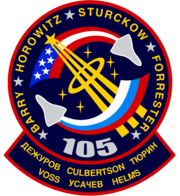STS-105

The launch of STS-105
|
|
| Mission type | ISS crew rotation |
|---|---|
| Operator | NASA |
| COSPAR ID | 2001-035A |
| SATCAT no. | 26888 |
| Mission duration | 11 days, 21 hours, 13 minutes, 52 seconds |
| Spacecraft properties | |
| Spacecraft | Space Shuttle Discovery |
| Launch mass | 116,914 kilograms (257,751 lb) |
| Landing mass | 100,824 kilograms (222,279 lb) |
| Payload mass | 9,072 kilograms (20,000 lb) |
| Crew | |
| Crew size | 7 |
| Members |
Scott J. Horowitz Frederick W. Sturckow Patrick G. Forrester Daniel T. Barry |
| Launching |
Frank L. Culbertson, Jr. Mikhail Turin Vladimir N. Dezhurov |
| Landing |
Yury V. Usachev James S. Voss Susan J. Helms |
| EVAs | 2 |
| EVA duration | 11 hours, 45 minutes |
| Start of mission | |
| Launch date | 10 August 2001, 21:10:14 UTC |
| Launch site | Kennedy LC-39A |
| End of mission | |
| Landing date | 22 August 2001, 18:23 UTC |
| Landing site | Kennedy SLF Runway 15 |
| Orbital parameters | |
| Reference system | Geocentric |
| Regime | Low Earth |
| Perigee | 373 kilometres (232 mi) |
| Apogee | 402 kilometres (250 mi) |
| Inclination | 51.6 degrees |
| Period | 92.3 minutes |
| Docking with ISS | |
| Docking port |
PMA-2 (Destiny forward) |
| Docking date | 12 August 2001 18:41 UTC |
| Undocking date | 20 August 2001 14:51 UTC |
| Time docked | 7 days, 20 hours, 9 minutes |
 Left to right. Centre group: Sturckow, Forrester, Barry, Horowitz. Top left (Expedition 2): Voss, Usachev, Helms. Top right (Expedition 3): Tyurin, Culbertson, Dezhurov |
|
STS-105 was a mission of the Space Shuttle Discovery to the International Space Station, launched from Kennedy Space Center, Florida, 10 August 2001. This mission was Discovery's final mission until STS-114, because Discovery was grounded for a refit, and then all Shuttles were grounded in the wake of the Columbia disaster. The refit included an update of the flight deck to the glass cockpit layout, which was already installed on Atlantis and Columbia.
The main purpose of STS-105 was the rotation of the International Space Station crew and the delivery of supplies utilizing the Italian-built Multi Purpose Logistics Module (MPLM) Leonardo on its second flight (STS-102, STS-105). The crew also performed two spacewalks and conducted scientific experiments. The Multi Purpose Logistics Module (MLPM) taken on STS-105 contained additional scientific racks, equipment and supplies. It is 6.4 meters (21 feet) long and 4.6 meters (15 feet) in diameter and weighs over 4,082 kilograms (8,999 lb). An identical module named Raffaello has flown twice (STS-100 and, later, STS-108).
Aboard Leonardo were six Resupply Stowage Racks, four Resupply Stowage Platforms, and two new scientific experiment racks for the station's U.S. laboratory Destiny. The two new science racks (EXPRESS Racks 4 and 5) added further science capability to the station. EXPRESS stands for Expedite the Processing of Experiments to the Space Station. EXPRESS Rack 4 weighs 533 kilograms (1,175 lb) and EXPRESS Rack 5 weighs 544 kilograms (1,199 lb). The empty weight of each EXPRESS rack is about 356 kilograms (785 lb). EXPRESS Racks 1 and 2A were delivered aboard the Raffaello cargo module during STS-100/6A in April 2001. EXPRESS Rack 3 was brought to the station during STS-111 in 2002.
...
Wikipedia

